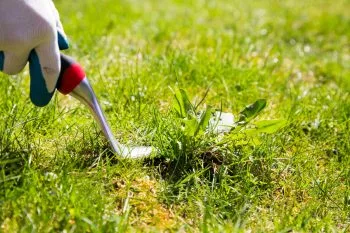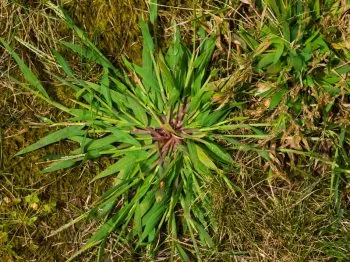What is crabgrass?
Crabgrass is an annual weed that grows in clumps. The word grass is in the name because yes, it is a grass, but not one that you want growing in your yard.
Crabgrass is not a beautiful, lush turf grass. It is just plain ugly. Crabgrass is extremely drought-resistant and heat tolerant. Once it starts growing, it spreads out very quickly.
Because crabgrass is an annual weed, it will die off in winter and not come back. The reason you will see it again in the spring is because before it died, it had been dropping seeds on your lawn since the previous spring.
One crabgrass plant can produce up to 10,000 seeds. Those seeds will quickly spread, germinate, and spread across your entire lawn. Crabgrass starts sprouting in spring and continues to germinate through late summer.
Here at Evergreen our lawn care specialists would be happy to help you get your lawn ready for spring.
How to Treat Crabgrass
This weed must be treated with a pre-emergent herbicide because post-emergent crabgrass herbicides will kill the crabgrass and your existing turfgrass.
A pre-emergent herbicide needs to be applied before you see any actual crabgrass plants. If your lawn has a history of crabgrass, you should absolutely apply a pre-emergent.
Crabgrass pre-emergent herbicides need to be applied in very early spring and then again 90 days later in early summer. The optimal time to do this is 2 weeks before the “average” last freeze date in your area. For the Dallas-Fort Worth areas, the recommended time is from March 5th-15th.
RELATED TIP: How to Kill Weeds Without Killing Grass
Your crabgrass preventer should not contain nitrogen. This is because at this time of year, our grass in Texas is still dormant. Using nitrogen on your turfgrass before it is green will make your grass less drought and heat resistant. It will also cause more weeds and diseases to develop.
Water your lawn well after applying pre-emergent herbicides and do so according to the directions on the label. The weedkiller will remain in the soil for weeks after the initial application destroying any seeds trying to sprout.
Steer clear of dethatching and aerating for a few weeks after putting down a crabgrass preventer because doing so will supply the crabgrass seeds with everything they need to grow such as, sunlight, moisture, and high temperatures.
Some top crabgrass preventers are:
- Pre-M
- Bonide Crabgrass Preventer
- Scotts Halt’s Crabgrass Preventer
- Dimension 2EW Herbicide
- Dacthal
- Princep
Final Thoughts

One thing to remember is that with crabgrass, the best option is weed prevention. You should be treating for crabgrass before you see any growing.
The second thing to remember is, make sure you apply the second dose. The second dose needs to be applied 3 months after the initial application. Doing one application without doing the other will not yield positive results.
As soon as you see a clump of crabgrass, remove it. Make sure you remove the plant and the roots. You can use a garden weeder tool to help get the roots out.
When you have hearty, dense grass, crabgrass is not able to invade your lawn. When you have a lawn with dry or bare spots; that is when the crabgrass will sneak in and start spreading.
RELATED TIP: When to Apply Pre-Emergent for Winter Weeds
Take care of your lawn. Having a healthy, green lawn takes work. Water your lawn well and fertilize your turfgrass. It is a year-round job, but well worth the work.



Comments (0)
Thanks for your comment!
Thanks for your feedback! Your comments have been successfully submitted! Please note, all comments require admin approval prior to display.
Error submitting comment!
There is a problem with your comment, please see below and try again.